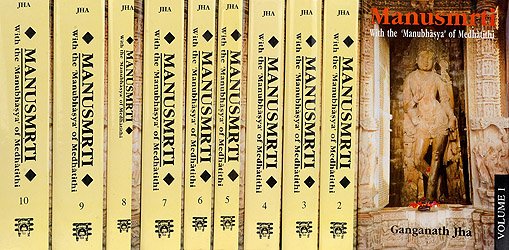Manusmriti with the Commentary of Medhatithi
by Ganganatha Jha | 1920 | 1,381,940 words | ISBN-10: 8120811550 | ISBN-13: 9788120811553
This is the English translation of the Manusmriti, which is a collection of Sanskrit verses dealing with ‘Dharma’, a collective name for human purpose, their duties and the law. Various topics will be dealt with, but this volume of the series includes 12 discourses (adhyaya). The commentary on this text by Medhatithi elaborately explains various t...
Verse 5.13
Sanskrit text, Unicode transliteration and English translation by Ganganath Jha:
प्रतुदाञ्जालपादांश्च कोयष्टिनखविष्किरान् ।
निमज्जतश्च मत्स्यादान् सौनं वल्लूरमेव च ॥ १३ ॥pratudāñjālapādāṃśca koyaṣṭinakhaviṣkirān |
nimajjataśca matsyādān saunaṃ vallūrameva ca || 13 ||Those birds that feed by striking with their beaks, those that are web-footed, the koyaṣṭi, those that scratch with their nails, those that dive and eat fish, slaughter-house meat, and dried meat.—(13)
Medhātithi’s commentary (manubhāṣya):
Those that feed by ‘striking’—piercing—‘with their beaks.’ Such is the nature of these birds. The Śatapatra and other birds belong to this class.
‘Web-footed’—The Āti and the rest. That there is an option in regard to this has already been pointed out above (Bhāṣya on 12.)
“Wherever there is an option, it depends upon the man’s wish which of the two options he will adopt: and as a matter of fact, it is only an unforbidden course that can be so adopted. The act of eating is an ordinary temporal act, possible only when there is a desire on the part of the man (to do it); it is not a spiritual act, which would have to be done in any case. So that we do not see any useful purpose that could be secured by an optional prohibition.”
Our answer to this is that this has already been answered.
“But what has been said may be all right in regard to cases where (as in the Veda) the comprehension of the meaning depends entirely upon the words of the text, and there is no intention (of any author) behind them (to indicate their true purport). The present treatise however is the work of a human author, having been composed by him with great care and labour. for the purpose of supplying in brief all the information that was contained in another voluminous work containing a hundred thousand verses; so that no needless word can be used in it. In fact it is for this reason (of his not using a single superfluous word) that the author comes to be regarded as a ‘Teacher’. It is not that there is no prohibition of all web-footed birds in general, in which case alone the prohibition of a particular web-footed bird, the Haṃsa, could be justified. Since the present verse also is a Smṛti-text (and it forbids all web-footed birds in general). Some people have held that the term ‘jālapāda’ (web-footed bird) in the present verse is a wrong reading”.
We have already explained that the intention of the Teacher is undersood with the help of gestures, actions and the spinning out of long explanations; and in the present case particular details are also inferred. What was meant to be said was that ‘one shall not eat web-footed birds in normal times’; but the author has propounded the prohibition in the wider form, with it view to justifying both prohibitions (of web-footed birds in general, and of the Haṃsa in particular).
‘Sūnā’ ‘Slaughter house’, is that place where animals are killed for the purpose of selling their flesh. Others explain it as ‘meat-market’.
‘Dried meat’, ‘Vallura’, is Mesh dried and kept for several days.
‘Nakhuviṣkira’ are those birds that scratch with their nails;—e.g. the Peacock, the Cock &c.
These birds are partly ‘fit to be eaten’ also, in view of the assertion that these may be eaten ‘in abnormal times;’ specially in view of what another Smṛti-writer has said regarding ‘the Cock among birds’ (being eatable). But the present text of Manu cannot be regarded as referring to the Cock; as in that case the separate mention of the ‘Cock’ would be useless.—(13)
Explanatory notes by Ganganath Jha
This verse is quoted in Vīramitrodaya (Āhnika, p. 540), which adds the following notes:—‘pratudāḥ’ are the birds that strike with the peak and then eat;—‘jālapāda’ is the web-footed bird, e.g. the cāṣa and the like;—‘koyaṣṭi’ is a species of wild birds;—‘nakhaviṣkira’ is the bird that scratches out food with its nails;—‘nimajjya matsyādān’ are those birds that catch fish by diving under water; e.g. the aquatic crow and the like;—‘sūnā’ is the slaughter-house, and ‘sauna’ is that which is got from there;—‘vallūra’ is dry fish.
It is quoted in Hemādri (Śrāddha, p. 583).
Comparative notes by various authors
Gautama. (17.35).—‘The peckers, the scratchers and birds that are not web-footed may be eaten.’
Vaśiṣṭha (14.18).—(See above.)
Viṣṇu (51.27).—‘On eating unrecognised meat, or meat from the slaughter-house or dry flesh, one should perform the Cāndrāyaṇa.
Yājñavalkya (1.172, 174, 175).—(See above,—and also) ‘Chāṣas, red-footed birds, meat from the slaughter-house and dry flesh,—on eating these; intentionally one should go without food for three days.’
